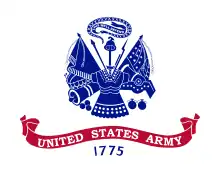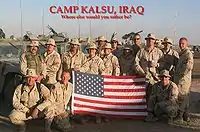Forward Operating Base Kalsu
Forward Operating Base Kalsu, also known as 'FOB Kalsu', COS Kalsu or simply Camp Kalsu, was a U.S. Military installation in Iskandariya, Iraq, 20 miles south of Baghdad. It was officially closed by members of the 1st Brigade Combat Team, 1st Cavalry Division, on December 12, 2011 as part of the US Army's withdrawal from Iraq.
Forward Operating Base Kalsu | |
|---|---|
| Iskandariya, Babil Governorate in Iraq | |
 Last Flag flown at FOB Kalsu by 105th MP Co | |
| Site information | |
| Owner | Ministry of Defence |
| Operator | United States Army |
| Site history | |
| Built | 2003 |
| In use | 2003-2011 |
| Battles/wars | Iraq War |
While under control of the Marines of the 24th Marine Expeditionary Unit, two Marines, Lance Corporal Ryan Krieger and Lance Corporal Christopher Roberts are credited with saving the base from being taken over by Iraqi militias by using hand to hand combat to subdue three members of the group from infiltrating the camp in the early morning hours of September 19, 2004. Krieger and Roberts were taking a smoke break while on watch and observed three masked men attempt to cross the berm in an attempt to breach the outer “wire”. The three men were taken to the base detention facility. One was a known terrorist on an internal watchlist. Two were later transported to Abu Ghraib Prison in Baghdad, while a third was transported to a prison detention facility at Camp Cropper near Baghdad International Airport. The pair of Marines did not seek recognition for their actions.[1]
History
FOB Kalsu was established in May 2003 by the New York Army National Guard unit the 105th Military Police (MP) Company, 104th Military Police Battalion, 53rd Troop Command based in Buffalo, NY. It was named in honor of Buffalo Bills and the University of Oklahoma All-American football player Bob Kalsu who was killed serving in the Vietnam War. The 105th and 300th MP companies were supported by elements of the Oregon Army National Guard's 1st Battalion, 162nd Infantry Regiment, 41st Infantry Brigade Combat Team and Bravo Company, 1092nd Engineer Combat Battalion, WV ARNG from August to November 2003.[2]
Subsequent deployments
After Operation Iraqi Freedom 1 (OIF1), FOB Kalsu was occupied by Company A, 1st Battalion, 152nd Infantry Regiment, Indiana Army National Guard from October 2003 to January 2004 acting as a quick reaction force (QRF) for Main Supply Route (MSR) Tampa and conducting combat patrols.
The base was then occupied by B Co, 2-505th Infantry Regiment, 82nd Airborne Division from January 2004 to May 2004 effectively conducting combat patrols and acting as the QRF for MSR Tampa.
It was then occupied by the 118th MP CO (ABN), 16th MP BDE (ABN) along with the attached A CO 1-185th Armor Regiment (Provisional Infantry), and the Mortar & Scout platoons of HHC 1-185th Armor, 81st Heavy Brigade Combat Team of the California Army National Guard from March 2004 to February 2005 conducting combat patrols and acting as a QRF for MSR Tampa. On May 25, 2004, Specialist Daniel P. Unger, Specialist Alan N. Bean Jr., and Sgt. Kevin F. Sheehan, were killed, along with numerous others wounded, during what some have described as one of the worst mortar attacks in the history of the war up until that time. [3] The new dining facility later built at FOB Kalsu was named "Unger Hall" in honor of Specialist Unger, who put the lives of several Iraqi workers he was guarding ahead of his own to ensure they were safely inside the bunker during the main attack, and was posthumously awarded the Bronze Star Medal with Valor for his heroism.[4]
In July 2004 the 24th Marine Expeditionary Unit (MEU), 1st Marine Division, assumed command of FOB Kalsu using it as a command post for operations in the Anbar Province and the areas south of Baghdad to northern part of Babil and then subsequently the assault on Fallujah in November 2004. One month after the Marines took over command of FOB Kalsu the mortar and rocket attacks dramatically decreased. In February 2005 155th Heavy Brigade Combat Team of the Mississippi Army National Guard assumed command through January 2006. 2d Squadron, 11th Armored Cavalry Regiment from FT Irwin, Ca, was attached to the 155th HBCT during this period. In November 2005 the 155th was visited by Mississippi Governor Haley Barbour.[5]
From November 2005 to November 2006, FOB Kalsu was occupied by 2nd Brigade Combat Team, 4th Infantry Division (United States) Led by Lt Col Howard and CSM Cervantes. Units of 2BCT/4ID that occupied FOB Kalsu included 2d Battalion 8th Infantry Regiment, 2d Special Troops Battalion, and 2d Brigade Headquarters Company. Prior to the end of the deployment 2d BCT's 3rd Battalion, 16th Field Artillery Regiment and 204th Brigade Support Battalion had also moved to FOB Kalsu.
Second Lieutenant Emily Perez was stationed at FOB Kalsu in September 2006 when, while leading a convoy conducting re-supply operations in the vicinity of Al-Najaf, her HMMWV hit an IED, making her the first female West Point graduate to be killed in Iraq.[6] The COS Troop Medical Clinic was named in her honor.[7]
From October 2006 to December 2007, FOB Kalsu was occupied by the 4th Brigade Combat Team (Airborne), 25th Infantry Division headquartered at Fort Richardson in Anchorage, Alaska.
In October 2007, the 4th BCT of the 3rd Infantry Division took control of the FOB.[8] In December 2008, the Vanguard Brigade transferred authority to the 172nd Infantry Brigade Combat Team (Blackhawk Brigade) headquartered at Grafenwoehr, Germany.[9]
From September 2009 to September 2010, COS Kalsu was manned by elements of 3HBCT (Heavy Brigade Combat Team), 3rd Infantry Division.
From September 23, 2010, and continuing until August 2011, COS Kalsu was occupied by the 3d Armored Cavalry Regiment, as well as their subordinate units, 1st Squadron 3rd Armored Cavalry Regiment (Tiger Squadron) and Regimental Support Squadron (Muleskinner Squadron) in support of Operation New Dawn.[10]
In July 2011 the 2nd Battalion, 5th Cavalry Regiment (2-5 CAV) and the 115th Brigade Support Battalion of the 1st Brigade Combat Team, 1st Cavalry Division replaced 3rd Armored Cavalry Regiment in support of Operation New Dawn.
Turnover in 2011
In December 2011, COS Kalsu was officially transferred to the care of the Iraqi Army and closed down by members of 2nd Battalion, 5th Cavalry Regiment, and 115th BSB, 1st Brigade Combat Team, 1st Cavalry Division.[11] [12]
References
- Stars and Stripes. “Cav troops help ensure security as U.S. winds down Iraq mission”, “Stars and Stripes”, 06 December 2011. Retrieved on 12 January 2019.
- "Early history of FOB Kalsu". GlobalSecurity.org. Retrieved 2004-08-15.
- Stars and Stripes news article. Retrieved on 11 November 2009.
- 24th Marine Expeditionary Unit News. Rerieved on 11 November 2009.
- Press Release from the Office of the Governor. “Governor Barbour Visits with Mississippi-based Fighting Unit in Iraq”, Gulf Coast News, Mississippi, 25 November 2005. Retrieved on 12 November 2019.
- Partlow, Joshua and Parker, Lonnae, O'Neal. “West Point Mourns a Font Of Energy, Laid to Rest by War”, “The Washington Post”, 27 September 2006. Retrieved on 12 January 2019.
- Quinlan, Constance. “Medics put training to test at new Kalsu aid station”, “Defense Visual Information Distribution Service”, 20 December 2007. Retrieved on 12 January 2019.
- Boyce, Paul. “Remaining 2007 Active-duty Army Iraq Rotation Announced May 8”, “Army News Service”, 08 May 2007. Retrieved on 12 January 2019.
- "Vanguard Brigade transfers authority to the 172nd Infantry Brigade". Task Force Mountain. Archived from the original on 2016-01-09. Retrieved 2008-12-29.
- Lacy, Alicia. “3rd Armored Cavalry Regiment deploys to Iraq”, “Killeen Daily Herald”, 26 August 2010. Retrieved on 12 January 2019.
- Renteria, Mark A. “Last One Out Turns Off the Lights: Closing a Military Base During the Withdrawal of Troops From Iraq”, “Army News Service”, 06 March 2013. Retrieved on 12 January 2019.
- DeMotts, Joshua L. “Cav troops help ensure security as U.S. winds down Iraq mission”, “Stars and Stripes”, 06 December 2011. Retrieved on 12 January 2019.